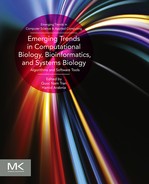Introduction
It gives us immense pleasure to present this edited book to the computational biology, bioinformatics, and systems biology research communities. As stated in the preface of this book, computational biology is the science of using biological data to develop algorithms and relations among various biological systems. It involves the development and application of data-analytical algorithms, mathematical modeling and simulation techniques to the study of biological, behavioral, and social systems. The field is multidisciplinary, in that it includes topics that are traditionally covered in computer science, mathematics, imaging science, statistics, chemistry, biophysics, genetics, genomics, ecology, evolution, anatomy, neuroscience, and visualization, and computer science acts as the topical bridge between these diverse areas. We consider the area of bioinformatics to be an important subfield of computational biology that includes methods for acquiring, storing, retrieving, organizing, analyzing, and visualizing biological data. The area of systems biology is an emerging methodology applied to biomedical and biological scientific research. It is an area that overlaps with computational biology and bioinformatics. This book is designed to cover the emerging trends in many important areas of computational biology, bioinformatics, and systems biology. The book is composed of 33 chapters, divided into four sections.
Section I, entitled “Computational Biology, Genetic Regulatory Networks, and Molecular Classification,” is composed of 9 chapters. They utilize various technologies, software tools, and algorithms to solve and address important problems. More specifically, the methods include supervised learning, neural networks, artificial intelligence, modeling, simulation, high-performance computing methods, statistical methods, clustering algorithms, classification techniques, and visualization.
The collection of 11 chapters compiled in Section II, “Bioinformatics, Databases, Data Mining, Pattern Discovery, Assistive Technologies, Signal Processing, and AI,” presents a number of important applications and describes novel uses of methodologies, including several in bioinformatics, databases, data mining, pattern discovery, assistive technologies, signal processing, and artificial intelligence (AI). More specifically, these chapters present clustering biological sequences, microRNA annotation, analysis of gene expressions, feature selection methods, DNA sequences and processing, health-care informatics and applications, toxicity prediction, biomedical methods, assistive tools and systems, neural models, and a philosophy of mind and cognition.
Section III, entitled “Systems Biology, Modeling and Simulation, Drug Design, and Discovery” is composed of 7 chapters. These chapters provide an insight and understanding of how different technologies are intertwined and used in concert to solve real and practical problems. More specifically, the topics presented in this section include combinatorial therapy of cancer, the DNA double-strand break (DSB) model, annotation of noncoding RNA, protein-folding methods, prediction techniques, the use of Bayesian belief networks for the diagnosis of main behavioral syndromes for Parkinson’s disease, virtual screening, and molecular docking.
Finally, Section IV, “Big Data and Data Analytics, Data Science, Data Processing, Medical Diagnosis, Computational Biology and Bioinformatics,” includes 6 chapters that describe algorithms and applications that are particularly data dependent. More specifically, they present methods for discovering knowledge in proteomic mass spectrometry data, next-generation sequencing data, quantification of in vivo magnetic resonance spectroscopy (MRS) metabolites, three-dimensional (3D) simulation of the cornea, business intelligence framework for a clinical laboratory, and methods for raw genomic data privacy.
The 33 chapters that appear in the four sections of this book are extended and edited versions of selected papers that were accepted for presentation at the 2013 and 2014 International Conference on Bioinformatics & Computational Biology (BIOCOMP’13 and BIOCOMP’14), which were held in July in Las Vegas, Nevada. Other authors (not affiliated with BIOCOMP) were also given the opportunity to contribute to this book by submitting their chapters for evaluation. We were fortunate to be coeditors of the proceedings of these annual conferences where the preliminary versions of most of these chapters first appeared. We are grateful to all authors who submitted papers for consideration. We thank the referees and members of the editorial board of BIOCOMP and the federated congress, WORLDCOMP. Without their help, this project would have neither been initiated nor finalized.
We hope that you learn from and enjoy reading the chapters of this book as much as we did.
